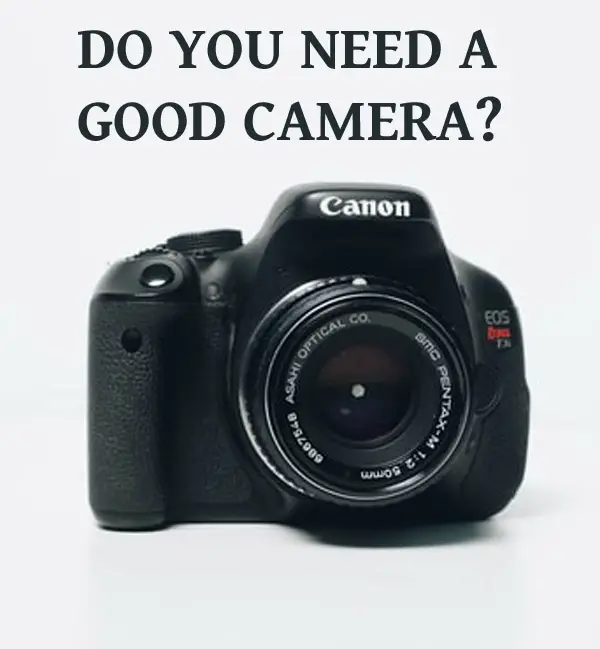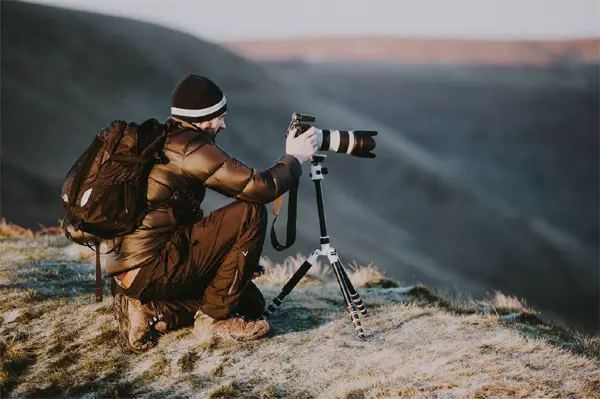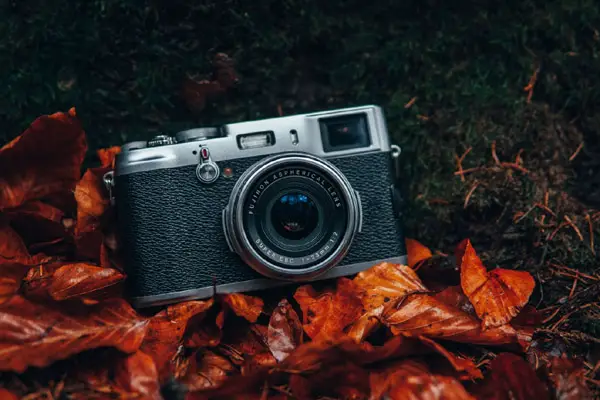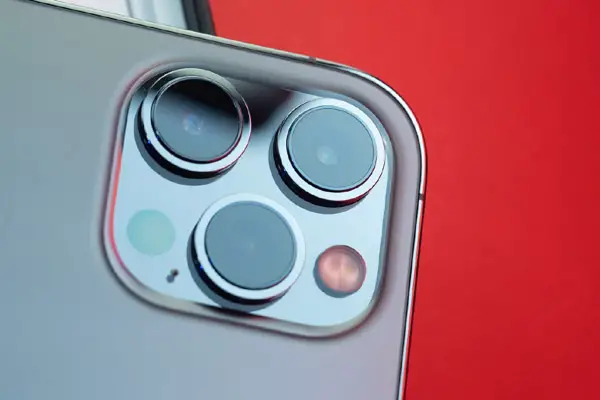Do You Need a Good Camera? What is Good Enough?
Do you really need a good camera to capture beautiful images? This question will be on the minds of many people who are looking to buy a new camera or those who are planning to start photography.

Let’s dive deep into what “good camera” means and whether you need one to be successful in what you are looking to achieve in photography.
The question of whether you need a good camera depends on what you are looking to achieve, what type of photography you will be performing, who you work for (if anyone), and whether there are specific image requirements. You do not necessarily need a good camera since you can use your skills to achieve exceptional images without a fancy camera. Not all good cameras are expensive.
Nowadays, we are seeing smartphones that come with 3 or more cameras that have multiple capabilities like macro, telephoto, wide-angle, portrait lens, etc. So, are these cameras capable of replacing the existing digital cameras and DSLRs?
There are numerous pros and cons of using a dedicated camera as well as a smartphone camera. We will see the various factors that will help you decide whether to use your smartphone camera or a DSLR/mirrorless camera for photography. Let us get started.
Good camera vs professional camera
If you are doing photography as a hobby, then any camera capable of capturing good pictures will be good for you. But, if you are going to take up photography as your profession, you will have to invest in professional cameras and lenses. When you are selling your pictures to your clients, you need to ensure that they are of great quality. So, a professional camera is a must. Also, when a client comes to book your photography service, he/she will inquire about your camera gear. You will get the work only if you own professional camera gear.
Are good cameras expensive?
Good cameras have a camera sensor with good noise performance. It allows you to capture beautiful images in any lighting conditions. Such cameras will have a good dynamic range. It allows you to capture the correct colors with good tonal details in the scene. Camera manufacturers would have put lots of effort and time to develop such cameras. So, these cameras tend to be a little expensive.
Do you need a DSLR/ Mirrorless camera?
There are different types of cameras out there. DSLR and mirrorless are the two popular camera types now. The decision to go with a DSLR/ mirrorless camera or not depends on a lot of factors. If you just want to capture some family pictures during your trips or vacation, you don’t have to invest in a DSLR camera. A normal digital camera or a smartphone with a good camera will be good enough to do this job.
If you are serious about photography and are interested in a photography genre like wildlife, landscape, birds, macro, etc, then it is a good idea to get a DSLR or mirrorless camera. If you want to capture beautiful bird images, then you can’t do it with a normal point and shoot camera or a smartphone camera. You will need a dedicated telephoto lens to capture bird images.

If you are interested in buying a DSLR/ Mirrorless camera, you need to buy the lens and the camera body separately. If you are interested to shoot multiple subjects like people, landscape, wildlife, you need to invest in dedicated lenses for each of these types of photography. You must ensure that you have a sufficient budget to invest in all this camera gear. You will also have to invest in camera accessories like a tripod, remote triggers, camera bag, etc.
Recording in RAW format
Another advantage of a DSLR/ mirrorless camera is the ability to capture the images in RAW format. It allows you to capture the maximum details in the scene. As you all know, JPEG is a lossy compressed image format. If you try to edit a JPEG image, you will end up losing more details. If you retouch a RAW image, then you can record more details in your final image. Professional photographers prefer this RAW recording capability of the interchangeable lens camera.
If you have recorded the image in RAW format and you have some minor exposure issues like blown highlights or crushed shadows, you can easily fix it during the post-processing stage. Sometimes, the white balance of the picture can go wrong in tricky lighting conditions, especially when you have set it to auto white balance. You can easily change the color temperature of the picture shot in RAW format. These RAW images will occupy a considerable amount of space on your hard disk. You will have to invest in external hard drives to store your images.
Camera settings
A DSLR/ mirrorless camera gives you more options to control different parameters of the image. Thus, it will help you to shoot in any lighting conditions for example, even ones the eye has trouble with. You must use the manual mode in the camera to gain access to all the settings. Once you master the manual mode in a DSLR camera, then you can capture images in any tricky conditions. It will help you to become a better photographer. If you want to take your photography to next level, consider investing in a good DSLR or a mirrorless camera with appropriate lenses.
You would have seen many images where the subject is in focus with a blurry background with beautiful bokeh. It is possible to capture such images using a DSLR camera. You can vary the aperture in a DSLR camera. A lower f-number that corresponds to a larger aperture opening helps to get a nice background blur provided there is some distance separation between the subject and the elements in the background.
If you want to capture birds in flight, you will have to use fast shutter speeds. The manual control of shutter speeds will allow you to set a higher shutter speed that can freeze any action. You can also use slower shutter speed to get the typical silky smooth landscape images that have the sea or any other water body like a waterfall in the scene.
If the scene is dark, you can increase the ISO in your camera to get a good exposure on the subject and thereby capture a properly exposed image. If you are doing long exposure photography like capturing star trails or light painting photography, you can easily set a slow shutter speed in your DSLR camera and get the desired effect on the image.
Nowadays there are smartphones that support background blur features. But, the background blur in these smartphones is generated by the software and not by the camera optics. So, it will not look that pleasing or real to the human eye.
Dynamic range factor
You can get a mirrorless camera with up to 15 stops of dynamic range. You will not be able to get the same dynamic range in a smartphone camera sensor. The dynamic range of a camera is its ability to capture the maximum light intensity as well as the minimum light intensity. If you are using a camera that supports a higher dynamic range, you can capture more tonal details in your image. Also, the dynamic range of the camera decreases when you increase the ISO levels.
Cost
When it comes to the cost factor, a DSLR or a mirrorless camera does not come that cheap. You will have to spend at least $300 to even get an entry-level DSLR camera with the basic kit lens option. Higher end cameras and lenses will cost you more. If you are planning to purchase one, you must ensure to have a real interest in photography. Otherwise, it will end up unused in your drawer.
You can watch this video to see whether it is still good to invest in a digital camera:
Are lenses more important than the camera?
When you consider an interchangeable lens camera like a DSLR or a mirrorless camera, there are two parts: a lens, and a camera body. As you know, the camera exposure is controlled by three parameters, aperture, shutter speed, and ISO. The aperture part originates in the lens and the shutter and ISO comes in the camera body.
The sensor inside the camera records the reflected light falling on it. It records the light for the duration in which the shutter remains open. So, most of the activity happens in the camera body. But, the amount of light entering into the lens is controlled by the aperture, which is in the lens part. The aperture does it with the help of the glass elements in the lens. The quality of these glasses will have a great impact on the image. If your lens is made up of high-quality coated glasses, then the phenomenon of refraction will be minimal. Hence, you will get the best quality images. Thus, the camera lens is as important as the camera body. If you check the price of a high-end camera lens, then it will cost more than the camera body. More importantly, camera bodies age very quickly and lose value pricewise whereas lenses hold their value.
Dedicated camera vs phone

When it comes to selecting a camera these days, you can have two options, you can either go with a dedicated camera or use the camera in your smartphone. Both have got their advantages as well as disadvantages.
Two devices vs One device
With the rapid advancement in smartphone camera technology, it is possible to capture high-quality pictures using a high-end smartphone. If you are using a dedicated camera, then you will have to carry it with you all the time when you plan to take pictures. On the other hand you carry your smartphone all the time anyway. It allows you to take good pictures anytime if the phone is equipped with a good camera. Thus, you can avoid the burden of carrying an additional camera.
Type of photography
You can’t use a smartphone camera to capture wildlife images. In the case of wildlife photography, you don’t have the luxury of getting close to the animals. You need to maintain a safe distance from the animal. It is for your safety as well as to ensure that the animal is comfortable with your presence. In this case, you will need a camera with a good optical zoom feature like a prosumer camera or a DSLR camera with a dedicated super-telephoto lens. Only then you can capture beautiful images of the wild animals.
Also if you download a cell phone image to a computer and open it to 500% or so zoom, you will see the difference in quality from a pro camera. Some cameras shoot at 50 megapixels. You can crop a small part of that photo and still print it large and sharp. You cannot do that with a phone photo.
Capturing selfies
Many people are interested to capture selfie pictures only. If you also belong to this category, then you won’t find a dedicated camera useful. It is easier to shoot a selfie using a smartphone camera than a standard digital camera. Most smartphones will come with front and back cameras. Thus, you can easily snap a selfie using any of these cameras.
Camera sensor size
A digital camera is specifically built for one purpose- to take good pictures. But, a camera comes as one of the features of a smartphone. Digital cameras come with a large sensor, unlike a smartphone camera. Unlike a digital camera, the smartphone is built to be compact and able to do a hundred different things. It is not possible to incorporate a large camera sensor into it.
With a large camera sensor in a digital camera, you will get larger pixels too. Larger pixels help to bring down the noise in the image when you shoot in low light or at high ISOs. If you capture the same low light scene using your smartphone camera, you can see noise in the picture visible in the form of grain.
Lens options

If you take the case of a smartphone camera, the lens options are limited. The high-end smartphones will come with 3 or 4 dedicated lenses for the camera, one for a basic phone. You can also get third-party lenses that can be the attached to the smartphone, which makes it bulky and the quality of an image produced by sticking a lens on top of existing lens and adding more glass elements (less light) is questionable.
If you take the case of an interchangeable lens camera like Sony a7iV, you can see that it supports a large number of lenses. You can get a portrait, macro, wide-angle, telephoto, super telephoto, fisheye lens, etc. You can get both prime as well as zoom lenses. Thus, an interchangeable lens camera gives you more flexibility.
Ease of Use
In the case of a smartphone camera, you can easily use it without referring to the manual. You can open the inbuilt smartphone camera app and start clicking pictures. In the case of a digital camera, you need to refer to the manual and see which are the buttons for setting different modes and parameters. You will have to learn the controls in the camera before taking photos. Once you learn the controls, then you can use them easily. Most digital cameras come with a user-friendly interface. If you compare these two cameras, then the smartphone camera will have a small upper hand when it comes to the ease of use factor.
But as phone camera creators try to add more features to their cameras, the software becomes more and more complicated and you have to really search to find all the features, they almost need a manual to read first. It is often easier to rely on physical buttons on a camera that have labels on them to set parameters.
Uploading/ Sharing with Friends/Social Media sites
Nowadays, most people take pictures to share with their friends through WhatsApp or to post on social media sites like Facebook or Instagram. When you use a digital camera for taking pictures, you will have to connect it to the computer using a data transfer cable or insert the memory card in the card reader and transfer the pictures to your computer for uploading. In the case of a smartphone, you can directly upload it. Thus, the process of sharing becomes much easy and simple with a smartphone.
Although as many people are finding out, the process of uploading photos from a phone to a computer via a cable is not that pleasant. Phones have many more folders than camera cards and your original/edited images may be all over the phone. It may even be difficult to sort them when you want to offload.
Well, thats a lot of comparisons. I hope i brought up some you were not thinking of and now you can make a better educated decision on whether you need a good camera for your purposes.
You can read the following article to know the different cameras that you can buy for under $300.




